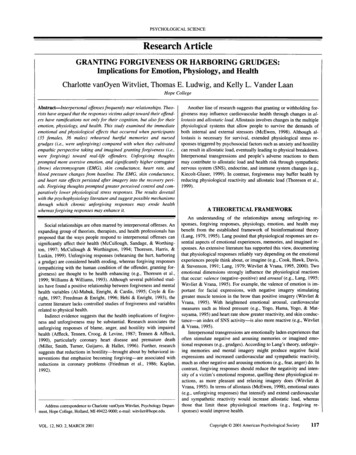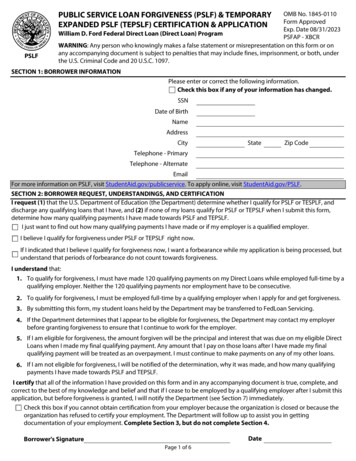
Transcription
PSYCHOLOGICAL SCIENCEResearch ArticleGRANTING FORGIVENESS OR HARBORING GRUDGES:Implications for Emotion, Physiology, and HealthCharlottevanOyenWitvliet, ThomasE. Ludwig, and Kelly L. VanderLaanHope CollegeAbstract- Interpersonaloffensesfrequentlymar relationships.Theorists have arguedthat the responsesvictimsadopt towardtheir offenders have ramificationsnot only for their cognition, but also for theiremotion,physiology, and health. This study examinedthe immediateemotional and physiological effects that occurred when participants(35 females, 36 males) rehearsed hurtful memories and nursedgrudges (i.e., were unforgiving)comparedwith when they cultivatedempathicperspective taking and imaginedgrantingforgiveness (i.e.,were forgiving) toward real-life offenders. Unforgiving thoughtspromptedmore aversive emotion, and significantlyhigher corrugator(brow) electromyogram(EMG), skin conductance, heart rate, andblood pressure changesfrom baseline. The EMG, skin conductance,and heart rate effects persisted after imagery into the recoveryperiods. Forgivingthoughtspromptedgreaterperceived controland comparatively lower physiological stress responses. The results dovetailwiththepsychophysiologyliteratureand suggestpossible mechanismsthrough which chronic unforgiving responses may erode healthwhereasforgiving responsesmay enhance it.Social relationshipsare often marredby interpersonaloffenses. Anexpandinggroup of theorists,therapists,and health professionalshasproposedthat the ways people respondto interpersonaloffenses cansignificantlyaffect their health (McCullough,Sandage, & Worthington, 1997; McCullough & Worthington,1994; Thoresen, Harris, &Luskin, 1999). Unforgivingresponses (rehearsingthe hurt,harboringa grudge)are consideredhealth eroding, whereas forgiving responses(empathizingwith the humancondition of the offender,grantingforgiveness) are thought to be health enhancing (e.g., Thoresen et al.,1999; Williams & Williams, 1993). Although several published studies have found a positive relationshipbetween forgivenessand mentalhealth variables (Al-Mabuk,Enright,& Cardis, 1995; Coyle & Enright, 1997; Freedman& Enright, 1996; Hebl & Enright, 1993), thecurrentliteraturelacks controlledstudies of forgiveness and variablesrelatedto physicalhealth.Indirectevidence suggests that the health implicationsof forgiveness and unforgivenessmay be substantial.Research associates theunforgivingresponses of blame, anger, and hostility with impairedhealth (Affleck, Tennen,Croog, & Levine, 1987; Tennen & Affleck,1990), particularly coronary heart disease and premature death(Miller, Smith, Turner,Guijarro,& Hallet, 1996). Further,researchsuggests that reductionsin hostility- broughtabout by behavioralinterventionsthat emphasize becoming forgiving- are associated withreductions in coronary problems (Friedman et al., 1986; Kaplan,1992).Address correspondence to Charlotte vanOyen Witvliet, Psychology Department, Hope College, Holland, MI 49422-9000; e-mail: witvliet@hope.edu.VOL. 12, NO. 2, MARCH 2001Anotherline of researchsuggests that grantingor withholdingforgiveness may influence cardiovascularhealth throughchanges in allostasis andallostatic load. Allostasis involves changes in the multiplephysiological systems that allow people to survive the demands ofboth internal and external stressors (McEwen, 1998). Although allostasis is necessary for survival, extended physiological stress responses triggeredby psychosocialfactorssuch as anxiety and hostilitycan resultin allostaticload, eventuallyleading to physical breakdown.Interpersonaltransgressionsand people's adverse reactions to themmay contributeto allostatic load and health risk throughsympatheticnervous system (SNS), endocrine,and immune system changes (e.g.,Kiecolt-Glaser, 1999). In contrast,forgiveness may buffer health byreducing physiological reactivityand allostatic load (Thoresenet al.,1999).A THEORETICAL FRAMEWORKAn understandingof the relationships among unforgiving responses, forgiving responses, physiology, emotion, and health maybenefit from the established frameworkof bioinformationaltheory(Lang, 1979, 1995). Lang posited that physiological responses are essential aspects of emotional experiences, memories,and imaginedresponses. An extensive literaturehas supportedthis view, documentingthatphysiological responsesreliablyvary dependingon the emotionalexperiencespeople think about,or imagine (e.g., Cook, Hawk, Davis,& Stevenson, 1991; Lang, 1979; Witvliet & Vrana, 1995, 2000). Twoemotional dimensions strongly influence the physiological reactionsthat occur: valence (negative-positive)and arousal (e.g., Lang, 1995;Witvliet & Vrana, 1995). For example, the valence of emotion is important for facial expressions, with negative imagery stimulatinggreatermuscle tension in the brow than positive imagery (Witvliet &Vrana, 1995). With heightened emotional arousal, cardiovascularmeasures such as blood pressure (e.g., Yogo, Hama, Yogo, & Matsuyama, 1995) and heartrateshow greaterreactivity,and skin conductance- an index of SNS activity- is also more reactive(e.g., Witvliet& Vrana, 1995).Interpersonaltransgressionsare emotionallyladenexperiencesthatoften stimulate negative and arousing memories or imagined emotional responses(e.g., grudges).Accordingto Lang's theory,unforgiving memories and mental imagery might produce negative facialexpressions and increasedcardiovascularand sympatheticreactivity,much as othernegativeand arousingemotions (e.g., fear,anger)do. Incontrast,forgiving responses should reduce the negativity and intensity of a victim's emotional response,quelling these physiological reactions, as more pleasant and relaxing imagery does (Witvliet &Vrana, 1995). In termsof allostasis (McEwen, 1998), emotionalstates(e.g., unforgivingresponses) that intensify and extend cardiovascularand sympathetic reactivity would increase allostatic load, whereasthose that limit these physiological reactions (e.g., forgiving responses) would improvehealth.Copyright 2001 American Psychological Society117
PSYCHOLOGICAL SCIENCEGrantingForgivenessor HarboringGrudgesholdingthe offenderresponsiblefor the transgression,anddoes not involve denying, or forgetting the offense (see Enright& Coyle, 1998). Although nouniversaldefinition of forgiveness exists, theorists emphasize that itThe literatureon forgivenesshas focused on the effects of two un- involvesletting go of the negativefeelings and adoptinga mercifulatforgivingresponses (rehearsingthe hurt,harboringa grudge) and two titude of goodwill towardthe offender (Thoresen,Luskin, & Harris,forgivingresponses (developingempathyfor the offender'shumanity, 1998). This may free the wounded person from a prison of hurt andgrantingforgiveness)to interpersonalviolations.vengeful emotion, yielding both emotional and physical benefits, including reduced stress, less negative emotion, fewer cardiovascularUnforgiving Responsesproblems,and improvedimmunesystem performance(McCulloughetal., 1997;Worthington,1998).PARTICULAR UNFORGIVING ANDFORGIVING RESPONSES TOINTERPERSONAL TRANSGRESSIONSRehearsingthe hurtOnce hurt, people often rehearsememories of the painful experience, even unintentionally,perhapsbecause the physiological reactivity that occurs during emotionally significant events facilitatesmemory encoding and retrieval(cf. Witvliet, 1997). When people rehearse hurtfulmemories, they may perpetuatenegative emotion andadversephysiologicaleffects (Witvliet, 1997; Worthington,1998). Interestingly,Huangand Enright(2000) found thatin the firstminuteofdescribing a past experience with conflict (vs. describing a typicalday), individuals who had forgiven because of religious pressureshowed greater blood pressure increases compared with those whohad forgivenbecause of unconditionallove.Harboringa grudgeWhen people hold a grudge,they stay in the victim role andperpetuate negative emotions associated with rehearsingthe hurtfuloffense(Baumeister,Exline, & Sommer, 1998). Despite this, victims may bedrawnto hold grudgesbecause they may secure tangibleor emotionalbenefits, such as a regained sense of control or a sense of "savingface" (Baumeisteret al., 1998). Yet nursinga grudge is considered"acommitmentto remainangry (or to resume anger periodically),"andto perpetuatethe adverse health effects associated with anger andblame (Baumeisteret al., 1998, p. 98).Forgiving ResponsesDevelopingfeelings of empathyDevelopingfeelings of empathyfor the perpetratoris consideredtoplay a pivotal role in turningthe victim away from unforgivenessandbeginning the forgiveness process (Worthington,1998). Empathyinvolves thinking of the offender's humanity(ratherthan defining theperson solely in terms of the offense) and trying to understandwhatfactorsmay have influencedthe offending behavior(Enright& Coyle,1998). When victims engage in this sort of perspectivetaking, the resulting empathiccompassionreducesthe intense arousaland negativevalence of hurts and grudges and introduces more positively valentemotion for the victim (McCullough et al., 1997). Empathy is alsothoughtto shift victims' facial expressions and reduce their stress responses in the cardiovascularand sympatheticnervoussystems (Worthington, 1998).GrantingforgivenessAPPLYING THE EMOTIONAL IMAGERY PARADIGMUnforgivingresponsesmay erode healthby activatingnegative,intense emotion and cardiovascularand SNS reactivity. Forgivingresponses may buffer health or promote healing by quelling cardiovascularreactivityand SNS hyperarousal(Thoresenet al., 1999). Inthis study,we investigatedthese hypothesesby measuringphysiologycontinuouslyas each participantthoughtabout a real-life offenderinunforgivingandforgivingways, providinga window into the momentby-momenteffects of choosing each response.We used a within-subjects repeated measures design (Vrana & Lang, 1990; Witvliet &Vrana, 1995, 2000), allowing us to compare the physical effects ofadopting unforgiving versus forgiving responses to a particularoffender.Building on the psychophysiologyliteraturerelevantto health,we measuredimagery effects on self-reportsof emotion valence andemotional arousal;self-reportsof perceived control, anger, and sadness; facial electromyogram (EMG) measured at the corrugator(brow) region; skin conductance (as an indicatorof SNS activity);heartrate;and blood pressure.We hypothesizedthat unforgivingimagery would promptmore negative and arousingemotion and hencelower perceivedcontrolthanforgiving imagery(cf. Witvliet& Vrana,1995). We also predictedthat unforgivingimagery would be associated with greaterincreases in corrugatormuscle tension and greaterskin conductance,heartrate, and blood pressurechanges (associatedwith ).Given the importancethat extended physiological reactivitymayhave for allostatic load and health consequences (e.g., McEwen,1998), we examinedwhetherdifferencesbetween the effects of unforgiving and forgiving imagerywould persistafterthe imageryperiods,when participantstried to stop their imagery and engaged in a relaxation task. Although such persistencehad not been tested previously,evidence from the traumaliteraturesuggests that negativeand arousing personal imagery that evokes heightenedphysiological reactivityis difficultto quell (cf. Witvliet, 1997). Physiologicaldifferencesmayalso persist because the valence and arousal of unforgivingimagerydiffers considerablyfrom the targetmood of relaxation.If the physiological reactivitypersists after imagery,unforgivingresponses to interpersonaloffenses may contributeto adversehealtheffects becausethe heightenedcardiovascularand SNS reactivityboth duringand after imagerymay increaseallostaticload.METHODThis study used a forgiveness builds on the core of empathy and involves adigm (Vrana& Lang, 1990;Witvliet& Vrana, 1995, 2000), adaptingcognitive, emotional, and possibly behavioralresponses (McCullough it to study the emotionaland physiologicaleffects of imaginingunforet al., 1997). It is importantto note that forgiveness still allows for giving and forgivingresponsesto an interpersonaloffender.118VOL. 12, NO. 2, MARCH200 1
sE. Ludwig, and Kelly L. ology studentsvoluntarilyparticipatedin this experiment.Because 1 female discontinuedthe study before its conclusion, the data for 71 (36 male, 35 female) participantsare reported.Data for 2 participantswere excluded from blood pressureanalysesbecauseof equipmentproblems.Stimulus MaterialsThe script materialsused to e based on the forgivenessliterature(McCulloughet al., 1997). To maximizeinternalvalidity,we had all participantsusethe same unforgivingscripts(rehearsingthe hurt,harboringa grudge)andforgivingscripts(empathizingwith the offender,grantingforgiveness). To maximizeexternalvalidity,we instructedeach participanttoapply all the unforgivingor forgiving responses to the same interpersonal offense from his or her life. This approachallowed us to assessthe emotionalandphysiologicaleffects of choosing to adoptunforgiving versus forgiving responses to a particularreal-life offender.Theimageryscriptsencouragedparticipantsto considerthe thoughts,feelings, and physical responses that would accompanyeach type of unforgivingand forgivingresponse.ApparatusWe used a Dell 486 computerto time the experimentalevents andcollect on-line physiologicaldata (VPM software;Cook, Atkinson,&Lang, 1987). Auditory tones at three frequencies- high (1350 Hz),medium (985 Hz), and low (620 Hz)- signaled imagery and relaxation trials. The tones were 500 ms long and 73 dB[A]. They weregenerated by a Coulbourn V85-05 Audio Source Module with ashaped-risetime set at 50 ms. The tones were presentedthroughAltecLansingACS41 speakerslocated2.5 feet to the left of the participant'shead during the instructions,and through Optimus Nova 67 headphonesduringdatacollection.FacialEMG was recordedat the corrugator(i.e., brow) muscle region using sensor placements suggested by Fridlundand Cacioppo(1986). Facial skin was preparedusing an alcohol pad and MedicalAssociates electrode gel. Then miniatureAg-AgCl electrodes filledwith Medical Associates electrode gel were applied. EMG signalswere amplified(X 50,000) by a Hi Gain V75-01 bioamplifier,using90-Hz high-passand 1-kHz low-pass filters.A Coulbournmultifunction V76-23 integrator(nominaltime constant 10 ms) then rectifiedand integratedthe signals.Skin conductancelevels (SCLs) were measuredby a Coulbournisolated skin conductanceV71-23 coupler using an applied constantvoltage of 0.5 V acrosstwo standardelectrodes.Electrodeswere filledwith a mixture of physiological saline and Unibase (Fowles et al.,1981) and appliedto the hypothenareminence on the left hand afteritwas rinsed with tap water.A 12-bit analog-digitalconvertersampledthe skin conductanceand facial EMG channelsat 10 Hz.Electrocardiogramdata were collected using two standardelectrodes,one on each forearm.A Hi GainV75-01 bioamplifieramplifiedand filteredthe signals.The signals were then sent to a digital inputonthe computerthat detected R waves and measuredinterbeatintervalsin milliseconds.We continuouslymeasuredblood pressureat each heartbeatwithan Ohmeda2300 Non-InvasiveBlood PressureMonitor,placing theVOL. 12, NO. 2, MARCH2001cuff between the first and second knuckleson the middle fingerof theleft hand.ProcedureEach participantcompleted a two-part,2-hr testing session. First,the participantidentifieda particularpersonhe or she blamedfor mistreating,offending, or hurtinghim or her. Then the participantcompleted a questionnaireabout the natureof the offense and his or herresponsesto it. Second, in the imageryphase of the study,the participant actively imagined each type of unforgiving and forgivingresponseto the previouslyidentifiedoffendereight times in systematically manipulatedorders that were counterbalancedacross participants. The study session was divided into blocks of trials, with twotypes of imagerytrials in each block. Acoustic tones (high, low) wereused to signal exactly when the participantwas to imagine each typeof forgiving or unforgivingresponse. Medium tones signaled participants to engage in a relaxationtask, thinkingthe wordone every timethey exhaled (e.g., Vrana & Lang, 1990; Witvliet & Vrana, 1995,2000).Physiology was monitoredcontinuouslyduringtrials consisting ofan 8-s baseline (relaxation)period, 16-s imagery period, and 8-s recovery (relaxation)period. On-line monitoringallowed us to measurethe immediate psychophysiological effects of people's unforgivingand forgivingresponsesas they occurred.After each block of imagerytrials, participantsratedtheir feelingsduringthe precedingtwo types of imagery.Using a video display andcomputer joystick (see Hodes, Cook, & Lang, 1985), participantsratedtheir level of emotional valence (negative-positive)and arousal(low-high), as well as anger,sadness, and perceivedcontrol.As a manipulationcheck, participantsalso ratedhow much empathythey feltfor the offenderand how much they felt they had forgiventhe offenderduringthe differentimageryconditions(fromnot at all to completely).All ratingswere convertedto a scale rangingfrom 0 to 20. Participantsprivatelyregisteredall ratings directly into a computerand were encouragedto be completely honest.Data Collection and ReductionDuring the experiment,participants'heartrate and blood pressurewere measuredon a heartbeat-to-heartbeatbasis, and facial EMG andSCL data were measuredon a second-to-secondbasis. Cardiacinterbeat intervalswere convertedoff-line to heartrate in beats per minutefor each imageryperiod.Withineach type of imagerycondition(hurt,grudge, empathy, forgiveness), the physiology measures were averaged over 4-s epochs, resultingin two 4-s epochs duringthe baselineperiod,four 4-s epochs duringthe imageryperiod,and two 4-s epochsduringthe recoveryperiod. Duringthe imageryand recoveryperiods,change scores for each 4-s epoch were created by subtractingvaluesfrom the 4-s baseline epoch immediatelybefore the imageryperiod.The hurt and grudge imagery trials were consideredto constitutethe unforgivingcondition because rehearsingthe hurt and holding agrudge are emotionally negative and arousing and are often experienced together (see Baumeisteret al., 1998). Thus, for the analyses,data for the hurt and grudge imagery trials were averaged.Similarly,the empathyand forgivenessimagerytrials were consideredto constitute theforgiving conditionbecause feeling empathyfor the perpetrator and grantingforgiveness are more positive and less arousing,andempathy is considered central to the forgiveness process (Worthing119
PSYCHOLOGICALSCIENCEGrantingForgivenessor HarboringGrudgeston, 1998). Thus, data for the empathy and forgiveness trials were averaged. The averaged data in the unforgiving condition were comparedwith the averaged data in the forgiving condition using analyses ofvariance (ANOVAs) with repeated measures.1 The overall effect ofemotion condition (forgiving vs. unforgiving imagery) during the imagery and recovery periods was assessed.2RESULTSTable 1. Mean self-ratings for the unforgiving and forgivingimagery conditionsImagery that their arents,and siblings. Common offenses includedbetrayalsof trust,rejection,lies, and onof the ratingsin the forgiving and unforgivingconditions revealspatternsconsistentwith predictions(Table 1). Duringunforgiving imagery, participants reported feeling more negativelyvalent,F(l, 70) 203.46,/? .001; aroused,F(l, 70)
Charlotte vanOyen Witvliet, Thomas E. Ludwig, and Kelly L. Vander Laan Participants Seventy-two introductory psychology students voluntarily partici- pated in this experiment. Because 1 female disconti











